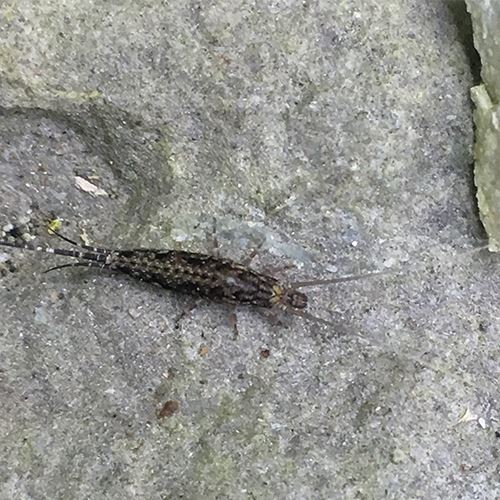Shimmering Bristletails

By: Karen Menard
Like a scaly, large-mandibled creature darting straight out of a sci-fi thriller, this half inch long beast spends most of its life hidden, slinking among the shadows of the forest floor. Officially known as a “jumping bristletail,” it can propel itself upwards of six inches or more if startled.
Uniquely able to push the middle and hind legs down together, these animals can swiftly spring into action by arching their body and slapping their abdomen against the ground to achieve lift-off. Their three-pronged or “bristle” tails attached to their back ends are gracefully suspended in tow. Not actually true “tails,” the middle appendage is called a terminal filament, used in reproduction, and the outer two are called cerci, important for movement or sensory abilities.
Having very thin exoskeletons that can dry quickly causes jumping bristletails to stay out of the heat. Typically nocturnal, they can only be found rarely during the day in the shade or in moist, rocky areas near leaf litter. However, if seen in direct sunlight, their fine, layered coat of reflective, pigmented scales, iridescently shimmers in all colors of the rainbow with a vibrant, coppery sheen.
Biologically, their role in the forest ecosystem is an important one, as their main job is recycling organic nutrients. Known to dine primarily on fungi, decaying plant matter, mosses, lichens, and algae, bristletails are considered beneficial insects that contribute to the decomposition process within forested habitats. Their mouthparts are mainly designed just for chewing soft, organic material and are too weak to bite humans or other animals.
Known as one of the first insects to show up in the fossil record, bristletails have been around since the mid-Devonian era (about 390 million years ago) and are considered pre-historic! They have been at work, underfoot, for eons, and it’s exciting to be able to still encounter their interesting presence as they continue to function as valuable ecosystem components.
Did you know?
These insects are considered long-lived and have a lifespan of around four years, with 24 species residing in North America. Jumping bristletails are part of an Order called Archaeognatha, which is derived from the Greek, archaios, meaning ancient and gnathos, meaning jaw.
---
Photo: Shimmering Bristletails (Karen Menard, Fallen Timbers Battlefield)